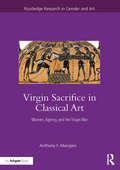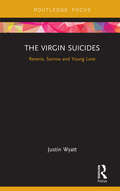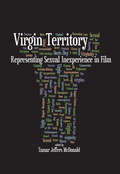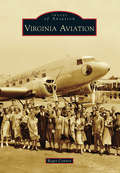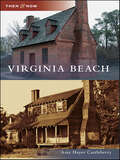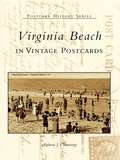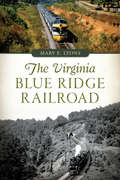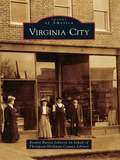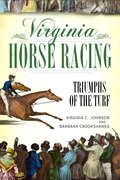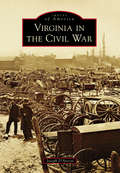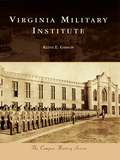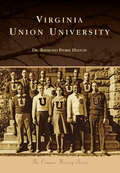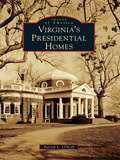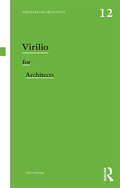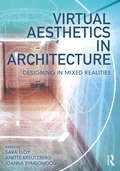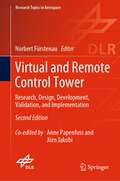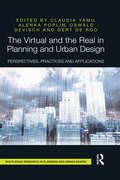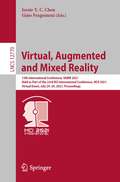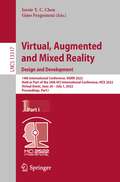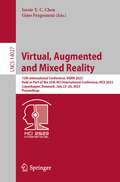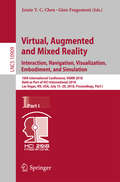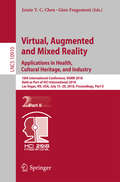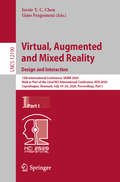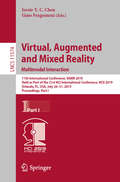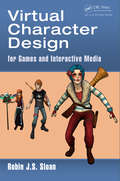- Table View
- List View
Virgin Sacrifice in Classical Art: Women, Agency, and the Trojan War (Routledge Research in Gender and Art)
by Anthony F. MangieriThe Trojan War begins and ends with the sacrifice of a virgin princess. The gruesome killing of a woman must have captivated ancient people because the myth of the sacrificial virgin resonates powerfully in the arts of ancient Greece and Rome. Most scholars agree that the Greeks and Romans did not practice human sacrifice, so why then do the myths of virgin sacrifice appear persistently in art and literature for over a millennium? Virgin Sacrifice in Classical Art: Women, Agency, and the Trojan War seeks to answer this question.This book tells the stories of the sacrificial maidens in order to help the reader discover the meanings bound up in these myths for historical people. In exploring the representations of Iphigeneia and Polyxena in Greek, Etruscan, and Roman art, this book offers a broader cultural history that reveals what people in the ancient world were seeking in these stories. The result is an interdisciplinary study that offers new interpretations on the meaning of the sacrificial virgin as a cultural and ideological construction. This is the first book-length study of virgin sacrifice in ancient art and the first to provide an interpretive framework within which to understand its imagery.
The Virgin Suicides: Reverie, Sorrow and Young Love (Cinema and Youth Cultures)
by Justin WyattBased on the best-selling novel by Jeffrey Eugenides, The Virgin Suicides is director Sofia Coppola’s evocative debut feature of young love, sex, loss and family pressures in mid-1970s America. Acclaimed by both critics and audiences on release, the film is now viewed as a remarkable and bold feature by a significant female director addressing many issues related to youth, female sexuality and family. This book helps readers understand the film’s significance and the stylistic and storytelling choices made by director Coppola. The analysis of the film occurs around three interlocking arguments: the unusual structuring absence in the film, the intricate manner through which music is used in the drama, communication and character creation, and the film’s careful and specific referencing of advertising in the 1970s (the decade of the film’s narrative). The film’s enigmatic structure and unique storytelling devices and their relationship to female adolescence, sexuality and ideology are also considered in depth. Without solving the mysteries of the film, the book is designed to uncover the reasons why the film continues to fascinate viewers so many years after its release.
Virgin Territory: Representing Sexual Inexperience in Film
by Tamar Jeffers McdonaldA critical and in-depth investigation of how virginity is represented in film.
Virginia Aviation (Images of Aviation)
by Roger ConnorVirginia has one of the oldest and richest aeronautical legacies in the country. Beginning with the use of balloons in the Civil War, the commonwealth was at the forefront of aerospace innovation, particularly in military aviation. Langley Field and Quantico were key development centers in the maturation of aerial warfare for the Army Air Service, its successors, and the Marine Corps. Norfolk witnessed the birth of the American carrier force and was on the front line in the Battle of the Atlantic. The state is also home to a legacy of civil and commercial activity. The National Advisory Committee for Aeronautics (NACA) laboratory at Langley Field established numerous foundational principles of modern aerodynamics, supported the development of many of the most significant aircraft of the 20th century, and paved the way for travel beyond Earth. Commercial airfields, including Richmond, Roanoke, and Washington's Hoover and National, were at the cutting edge of modern air travel and played host to aviation's elite. These images from local, state, and national archives--nearly all previously unpublished--depict a rich technological heritage.
Virginia Beach
by Amy Hayes CastleberryVirginia Beach offers a variety of attractions, but few who visit know that there is an area with a history that dates back to the 17th century. Many early structures remain intact and appreciated, while others fell into ruin and exist only in photographs and memories. Then & Now: Virginia Beach is a road trip through the past and present.
Virginia Beach in Vintage Postcards
by Alpheus J. ChewningFirst visited by English settlers in 1607, Virginia Beach has been a popular tourist destination ever since. The sea, sand, and sun are the most popular attractions, but throughout history the city has also been known for its unique architecture. The first geodesic dome built in the United States, designed by Buckminster Fuller, was the city's convention center for many years. The Cavalier Hotel, when built in 1927, was the state's largest brick structure. The new Cape Henry lighthouse, completed in 1881, remains the tallest cast iron lighthouse in the country. The lighthouse it replaced, a structure that still stands today, was erected in 1791 and was the first federally funded structure built in the United States.
The Virginia Blue Ridge Railroad (Transportation)
by Mary E. LyonsIn 1849, Virginia began a bold railroad expansion toward the Ohio River and its lucrative trade connections. The project's plan covered 423 miles and called for piercing two mountain chains with three railroads. The Blue Ridge Railroad was the shortest of these but crossed the most mountainous terrain. At times, hired slaves, who prepared the tracks, and Irish immigrants, who blasted the tunnels, faced challenges that seemed almost insurmountable. Many were killed by explosions and falling rock. Those deaths often resulted in labor strikes. The unrest slowed progress and haunted chief engineer Claudius Crozet for seven years. In this first full-length history of the Blue Ridge Railroad, award-winning author Mary E. Lyons uses a wealth of historical documents to describe construction on what Crozet called "dangerous ground."
Virginia City
by Thompson-Hickman County LibraryTucked between the Tobacco Root Mountains and Mount Baldy in southwestern Montana, Virginia City began in May 1863, when gold was discovered in Alder Gulch. Some 10,000 fortune seekers arrived, and the days of whiskey, revolvers, road agents, and vigilantes began. Boot Hill, overlooking the town, is a constant reminder of its rough, tough, and unruly past. A great number of mining towns have become ghost towns, but not Virginia City, thanks to the men and women who gave of themselves to establish a permanent town where families, schools, churches, businesses, and organizations would thrive.
Virginia Horse Racing: Triumphs of the Turf (Sports)
by Virginia C. Johnson Barbara CrookshanksVirginia, mother of presidents, is also the mother of American horse racing. From the very beginning, Virginians have risked it all on the track as eagerly as on the battlefield. Follow the bloodlines of three foundation sires of the American Thoroughbred through generations of rollicking races and larger-than-life grandees wagering kingly stakes, sometimes on horses not yet born. How did the horse nicknamed Damn His Eyes get protection money from other horse owners? What did it mean to �tap the claret� to break a neck-and-neck tie? Why was Confederate cavalry so much better than Union�was it the riders, or was it the mounts? All these and many more stories of horsemanship on and off the track fill the pages of Virginia Horse Racing: Triumphs of the Turf.
Virginia in the Civil War (Images of America)
by Joseph D'ArezzoNo other event in American history has so indelibly shaped the country than the American Civil War. Virginia provided the setting for countless bloody clashes and decisive battles. Average Americans from all over the Union and the Confederacy made their way to the Old Dominion, only to give their lives for the causes they held dear. Virginia captures the essence of the American Civil War, as it was the site of the first, and last, major clash. The state held the capital of the Confederacy while simultaneously bordering Washington, DC. Additionally, Virginia was the site of infamous battles, such as Manassas, Fredericksburg, and Chancellorsville. The commonwealth was also the location of Gen. Robert E. Lee's dramatic capitulation to Gen. Ulysses S. Grant at Appomattox. The American Civil War was one of the first armed conflicts to be heavily documented through photographs. In recent years, the Library of Congress has compiled many of these images, helping to make this journey through history possible.
Virginia Military Institute (Campus History)
by Keith E. GibsonIn 1839, the Virginia Military Institute became the nation's first state-sponsored military college when the state arsenal in Lexington, Virginia, adopted an additional duty providing a college education to a small group of cadets. This humble experiment became the nation's model for educating the citizen-soldier. Today cadets live a military lifestyle while pursuing an undergraduate degree and may choose to accept a commission in any branch of the armed forces upon graduation. Noted alumni include Pony Express organizer Ben Ficklin (1849), Nobel Peace Prize recipient Gen. George Marshall (1901), Polar explorer Adm. Richard Byrd (1908), U.S. Supreme Court Justice Tom Clark (1921), and actor Dabney Coleman (1957). Numbered among the alumni are over 260 general officers, 13 Rhodes Scholars, and a saint in the Episcopal Church. The Post, as the campus is called, is a National Historic District with its distinctive Gothic Revival architecture surrounding the central parade ground.
Virginia Union University
by Dr Raymond HyltonSince its founding by the American Baptist Home Mission Society in 1865, Virginia Union University has nurtured its students for nearly 150 years. Its first campus was established on the site of the Lumpkin slave prison in what was then the notorious Shockoe Bottom district of Richmond, Virginia, thus replacing a horrific purpose with one dedicated to education and enlightenment. Four historically black institutions came together into one university: Richmond Theological Seminary, Wayland Seminary, Hartshorn Memorial College for African American women, and Storer College. Overcoming Jim Crow laws and racial adversity, Virginia Union University became the center of a renowned theological school and a focal point during the civil rights movement, matriculating leaders such as Wyatt Tee Walker, Walter Fauntroy, and Elizabeth Rice and igniting the Richmond Campaign for Human Dignity in the wake of the arrest of the Virginia Union 34 during the 1960 sit-ins. Today, Virginia Union is a vibrant urban university offering graduate education in ministry, Christian education, and divinity and undergraduate degrees through the Schools of Business, Humanities & Social Sciences, Education, Psychology & Interdisciplinary Studies, and Mathematics, Science & Technology. Under the leadership of Dr. Claude Grandford Perkins, Virginia Union's 12th president, the university carries on its proud legacy of achievement.
Virginia's Presidential Homes
by Patrick L. O'NeillImages of America: Virginia's Presidential Homes takes a visual excursion to the homes of the eight Virginia-born men who served as president of the United States: George Washington, Thomas Jefferson, James Madison, James Monroe, William Henry Harrison, John Tyler, Zachary Taylor, and Woodrow Wilson. Virginia, nicknamed the "Mother of Presidents," is the birthplace of these eight men who were key to the success of the American Revolution, the forming of the U.S. government, the War of 1812, the annexation of Texas, the Mexican-American War, and World War I. Coming from diverse backgrounds and classes, their residences ranged from simple wood-frame structures to elegant, brick-pillared mansions and estates. Through images and drawings, this book will bring to life their homes and family life.
Virilio for Architects (Thinkers for Architects)
by John ArmitagePaul Virilio is an innovative figure in the study of architecture, space, and the city. Virilio for Architects primes readers for their first encounter with his crucial texts on some of the vital theoretical debates of the twenty-first century, including: Oblique Architecture and Bunker Archeology Critical Space and the Overexposed City The Ultracity and Very High Buildings Grey Ecology and Global Hypermovement In exploring Virilio’s most important architectural ideas and their impact, John Armitage traces his engagement with other key architectural and scientific thinkers such as Claude Parent, Benoit B. Mandelbrot, and Bernard Tschumi. Virilio for Architects allows students, researchers, and non-academic readers to connect with Virilio’s distinctive architectural theories, critical studies, and fresh ideas.
Virtual Aesthetics in Architecture: Designing in Mixed Realities
by Sara Eloy Anette Kreutzberg Ioanna SymeonidouVirtual Aesthetics in Architecture: Designing in Mixed Realities presents a curated selection of projects and texts contributed by leading international architects and designers who are using virtual reality technologies in their design process. It triggers discussion and debate on exploring the aesthetic potential and establishing its language as an expressive medium in architectural design. Although virtual reality is not new and the technology has evolved rapidly, the aesthetic potential of the medium is still emerging and there is a great deal more to explore. The book provides a comprehensive overview of the current use of virtual reality technologies in the architectural design process. Contributions are presented in six parts, fully illustrated with over 150 images. Recent projects presented are distributed in five themes: introduction to mixed realities; space and form; context and ambiguity; materiality and movement; body and social. Each theme includes richly illustrated essays by leading academics and practitioners, including those from Zaha Hadid Architects and MVRDV, detailing their design process using data-driven methodologies. Virtual Aesthetics in Architecture expands the use of technology per se and focuses on how architecture can benefit from its aesthetic potential during the design process. A must-read for practitioners, academics, and students interested in cutting-edge digital design.
Virtual and Remote Control Tower: Research, Design, Development, Validation, and Implementation (Research Topics in Aerospace)
by Norbert FürstenauThis book presents the interdisciplinary and international “Virtual and Remote Tower” research and development work. It has been carried out since nearly twenty years with the goal of replacing the conventional aerodrome control tower by a new “Remote Tower Operation” (RTO) work environment for enhancing work efficiency and safety and reducing cost. The revolutionary human–system interface replaces the out-of-windows view by an augmented vision video panorama that allows for remote aerodrome traffic control without a physical tower building. It enables the establishment of a (multiple) remote control center (MRTO, RTC) that may serve several airports from a central location. The first (2016) edition of this book covered all aspects from preconditions over basic research and prototype development to initial validation experiments with field testing. Co-edited and -authored by DLR RTO-team members Dr. Anne Papenfuss and Jörn Jakobi, this second extended edition with nearly doubled number of chapters includes further important aspects of the international follow-up work towards the RTO-deployment. Focus of the extension with new contributions from ENRI/Japan and IAA/Dublin with Cranfield University, is on MRTO, workload, implementation, and standardization. Specifically, the two revised and nine new Chapters put the focus on inclusion of augmented vision and virtual reality technologies, human-in-the-loop simulation for quantifying workload and deriving minimum (technical) requirements according to standards of the European Organization for Civil Aviation Equipment (EUROCAE), and MRTO implementation and certification. Basics of optical / video design, workload measures, and advanced psychophysical data analysis are presented in four appendices.
The Virtual and the Real in Planning and Urban Design: Perspectives, Practices and Applications
by Claudia Yamu Alenka Poplin Oswald Devisch Gert De RooThe Virtual and the Real in Planning and Urban Design: Perspectives, Practices and Applications explores the merging relationship between physical and virtual spaces in planning and urban design. Technological advances such as smart sensors, interactive screens, locative media and evolving computation software have impacted the ways in which people experience, explore, interact with and create these complex spaces. This book draws together a broad range of interdisciplinary researchers in areas such as architecture, urban design, spatial planning, geoinformation science, computer science and psychology to introduce the theories, models, opportunities and uncertainties involved in the interplay between virtual and physical spaces. Using a wide range of international contributors, from the UK, USA, Germany, France, Switzerland, Netherlands and Japan, it provides a framework for assessing how new technology alters our perception of physical space.
Virtual, Augmented and Mixed Reality: 13th International Conference, VAMR 2021, Held as Part of the 23rd HCI International Conference, HCII 2021, Virtual Event, July 24–29, 2021, Proceedings (Lecture Notes in Computer Science #12770)
by Jessie Y. C. Chen Gino FragomeniThis book constitutes the refereed proceedings of the 13th International Conference on Virtual, Augmented and Mixed Reality, VAMR 2021, held virtually as part of the 23rd HCI International Conference, HCII 2021, in July 2021. The total of 1276 papers and 241 posters included in the 39 HCII 2021 proceedings volumes was carefully reviewed and selected from 5222 submissions. The 47 papers included in this volume were organized in topical sections as follows: designing and evaluating VAMR environments; multimodal and natural interaction in VAMR; head-mounted displays and VR glasses; VAMR applications in design, the industry and the military; and VAMR in learning and culture.
Virtual, Augmented and Mixed Reality: 14th International Conference, VAMR 2022, Held as Part of the 24th HCI International Conference, HCII 2022, Virtual Event, June 26 – July 1, 2022, Proceedings, Part I (Lecture Notes in Computer Science #13317)
by Jessie Y. C. Chen Gino FragomeniThis two-volume set LNCS 13317 and 13318 constitutes the thoroughly refereed proceedings of the 14th International Conference on Virtual, Augmented and Mixed Reality, VAMR 2022, held virtually as part of the 24rd HCI International Conference, HCII 2022, in June/July 2022.The total of 1276 papers and 241 posters included in the 39 HCII 2021 proceedings volumes was carefully reviewed and selected from 5222 submissions. The 56 papers included in this 2-volume set were organized in topical sections as follows: Developing VAMR Environments; Evaluating VAMR environments; Gesture-based, haptic and multimodal interaction in VAMR; Social, emotional, psychological and persuasive aspects in VAMR; VAMR in learning, education and culture; VAMR in aviation; Industrial applications of VAMR. The first volume focuses on topics related to developing and evaluating VAMR environments, gesture-based, haptic and multimodal interaction in VAMR, as well as social, emotional, psychological and persuasive aspects in VAMR, while the second focusses on topics related to VAMR in learning, education and culture, VAMR in aviation, and industrial applications of VAMR.
Virtual, Augmented and Mixed Reality: 15th International Conference, VAMR 2023, Held as Part of the 25th HCI International Conference, HCII 2023, Copenhagen, Denmark, July 23–28, 2023, Proceedings (Lecture Notes in Computer Science #14027)
by Jessie Y. C. Chen Gino FragomeniThis book constitutes the refereed proceedings of the 15th International Conference on Virtual, Augmented and Mixed Reality, VAMR 2023, held as part of the 25th International Conference, HCI International 2023, in Copenhagen, Denmark, in July 2023. The total of 1578 papers and 396 posters included in the HCII 2022 proceedings was carefully reviewed and selected from 7472 submissions. The VAMR 2023 proceedings were organized in the following topical sections: Designing VAMR Applications and Environments; Visualization, Image Rendering and 3D in VAMR; Multimodal Interaction in VAMR; Robots and Avatars in Virtual and Augmented Reality; VAMR in Medicine and Health; VAMR in Aviation; and User Experience in VAMR.
Virtual, Augmented and Mixed Reality: 10th International Conference, VAMR 2018, Held as Part of HCI International 2018, Las Vegas, NV, USA, July 15-20, 2018, Proceedings, Part I (Lecture Notes in Computer Science #10909)
by Jessie Y.C. Chen Gino FragomeniThis two-volume set LNCS 10909 and 10910 constitutes the refereed proceedings of the 10th International Conference on Virtual, Augmented and Mixed Reality, VAMR 2018, held as part of HCI International 2018 in Las Vegas, NV, USA. HCII 2018 received a total of 4346 submissions, of which 1171 papers and 160 posters were accepted for publication after a careful reviewing process. The 65 papers presented in this volume were organized in topical sections named: interaction, navigation, and visualization in VAMR; embodiment, communication, and collaboration in VAMR; education, training, and simulation; VAMR in psychotherapy, exercising, and health; virtual reality for cultural heritage, entertainment, and games; industrial and military applications.
Virtual, Augmented and Mixed Reality: 10th International Conference, VAMR 2018, Held as Part of HCI International 2018, Las Vegas, NV, USA, July 15-20, 2018, Proceedings, Part II (Lecture Notes in Computer Science #10910)
by Jessie Y.C. Chen Gino FragomeniThis two-volume set LNCS 10909 and 10910 constitutes the refereed proceedings of the 10th International Conference on Virtual, Augmented and Mixed Reality, VAMR 2018, held as part of HCI International 2018 in Las Vegas, NV, USA. HCII 2018 received a total of 4346 submissions, of which 1171 papers and 160 posters were accepted for publication after a careful reviewing process. The 65 papers presented in this volume were organized in topical sections named: interaction, navigation, and visualization in VAMR; embodiment, communication, and collaboration in VAMR; education, training, and simulation; VAMR in psychotherapy, exercising, and health; virtual reality for cultural heritage, entertainment, and games; industrial and military applications.
Virtual, Augmented and Mixed Reality. Design and Interaction: 12th International Conference, VAMR 2020, Held as Part of the 22nd HCI International Conference, HCII 2020, Copenhagen, Denmark, July 19–24, 2020, Proceedings, Part I (Lecture Notes in Computer Science #12190)
by Gino Fragomeni Jessie Y. C. ChenThe 2 volume-set of LNCS 12190 and 12191 constitutes the refereed proceedings of the 12th International Conference on Virtual, Augmented and Mixed Reality, VAMR 2020, which was due to be held in July 2020 as part of HCI International 2020 in Copenhagen, Denmark. The conference was held virtually due to the COVID-19 pandemic.A total of 1439 papers and 238 posters have been accepted for publication in the HCII 2020 proceedings from a total of 6326 submissions.The 71 papers included in these HCI 2020 proceedings were organized in topical sections as follows:Part I: design and user experience in VAMR; gestures and haptic interaction in VAMR; cognitive, psychological and health aspects in VAMR; robots in VAMR.Part II: VAMR for training, guidance and assistance in industry and business; learning, narrative, storytelling and cultural applications of VAMR; VAMR for health, well-being and medicine.
Virtual, Augmented and Mixed Reality. Multimodal Interaction: 11th International Conference, VAMR 2019, Held as Part of the 21st HCI International Conference, HCII 2019, Orlando, FL, USA, July 26–31, 2019, Proceedings, Part I (Lecture Notes in Computer Science #11574)
by Jessie Y. C. Chen Gino FragomeniThis two-volume set LNCS 11574 and 11575 constitutes the refereed proceedings of the 11th International Conference on Virtual, Augmented and Mixed Reality, VAMR 2019, held in July 2019 as part of HCI International 2019 in Orlando, FL, USA. HCII 2019 received a total of 5029 submissions, of which 1275 papers and 209 posters were accepted for publication after a careful reviewing process. The 80 papers presented in this volume were organized in topical sections named: multimodal interaction in VR, rendering, layout, visualization and navigation, avatars, embodiment and empathy in VAMR, cognitive and health issues in VAMR, VAMR and robots, VAMR in learning, training and entertainment, VAMR in aviation, industry and the military.
Virtual Character Design for Games and Interactive Media
by Robin James SloanWhile the earliest character representations in video games were rudimentary in terms of their presentation and performance, the virtual characters that appear in games today can be extremely complex and lifelike. These are characters that have the potential to make a powerful and emotional connection with gamers. As virtual characters become more
